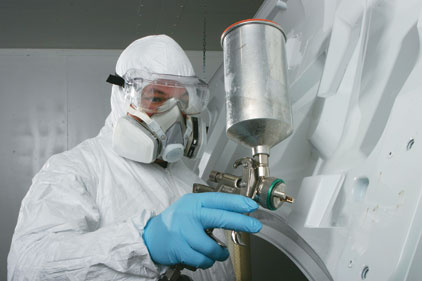|
6 Steps to Respiratory Protection |
| Exposure assessment |
| Written respiratory program |
| Respiratory selection |
| Medical evaluation |
| Fit testing |
| Respiratory training |
With this statistic in mind, OSHA has continued to regulate and enforce workplace respiratory safety standards. Employers are required by law to provide a safe workplace, including ongoing efforts to find and correct safety and health problems. Rather than simply providing personal protective equipment such as respirators in hazardous workplaces, OSHA requires employers to eliminate or reduce hazards by revising the physical work conditions comprehensively, and then supply the appropriate protective equipment following workplace revisions.
In the specific case of hazardous respiratory conditions, OSHA requires that an employer develop and implement a respiratory protection program. Six steps may be taken when addressing respiratory conditions to ensure the health and safety of workers and compliance with OSHA regulations.
1 Exposure assessment
New technologies and processes have brought on new potential risks on worksites. For example, the hydraulic fracturing process, also known as fracking, releases crystalline silica, or frac sand, exposing workers to harmful amounts of silica. As processes and methods on worksites are further developed, new contaminants are added to the list of potential threats to workers.
This is why OSHA requires an employer to identify and evaluate respiratory hazards, as well as specify the culprit
contaminant on a semi-regular basis. A contracted industrial hygienist typically conducts this assessment, which is usually done in conjunction with ongoing air monitoring. Contact the American Industrial Hygiene Association (AIHA) for a list of recommended professionals. OSHA also offers a free
consultation program.
Your assessment findings will affect the measures taken throughout the rest of the process toward respiratory protection.
2 Written respiratory program
Based on the findings of an exposure assessment, a written respiratory protection program is required. This plan establishes mandatory use of respirators with site-specific procedures. Once finalized, the program must then be carried out and implemented by a suitably trained program administrator. This person is typically a trained individual or the safety director of the company managing the work site.
3 Respirator selection
Based on a workplace’s air contaminants and concentration levels, other relevant workplace hazards and user factors, an employer must select appropriate respirators for the workforce. Respirator type or class is selected by comparing employees’ hazard exposure to the occupational exposure limit and then determining the minimum necessary protection factor.
Respirators come in two main categories: particulate/air-purifying varietals which capture contaminants, and supplied-air models which provide the worker with clean respirable air from another source. Manufacturers of respiratory products in the U.S. have developed a full assortment of products to meet every hazard level. Models have evolved to become more economical and comfortable, including low-profile filters to fit under welding helmets and harnesses to more evenly distribute weight when wearing and removing the respirator.
4 Medical evaluation
Medical evaluation of all employees is required for mandatory use of all respirators or voluntary use of elastomeric face pieces, and is recommended for voluntary use of filtering face piece respirators.
5 Fit testing
Fit testing of respirators is necessary to ensure a secure fit. Testing must occur prior to initial use of the respirator and whenever a piece of the respirator is changed or replaced (does not include the changing of cartridges and filters). Testing must also occur if the style or brand changes or the work operation or environment changes, and then annually thereafter.
6 Respiratory training
Effective training must be provided to all employees who wear respirators. It is essential for this training to be comprehensive and understandable. Training should occur annually or as needed for new hires. Training programs are offered through OSHA, as well as many manufacturers of respiratory protection equipment.
Following this six-step program will ensure the safety of employees and help maintain an employer’s compliance with OSHA, preventing future workplace injuries, illnesses and liabilities. Consultation and assistance in workplace assessment and plan implementation is offered through OSHA or through product manufacturers.
For more information, reference the OSHA Respiratory Protection Standard 29 CFR 1910. Visit www.osha.gov for more information.
